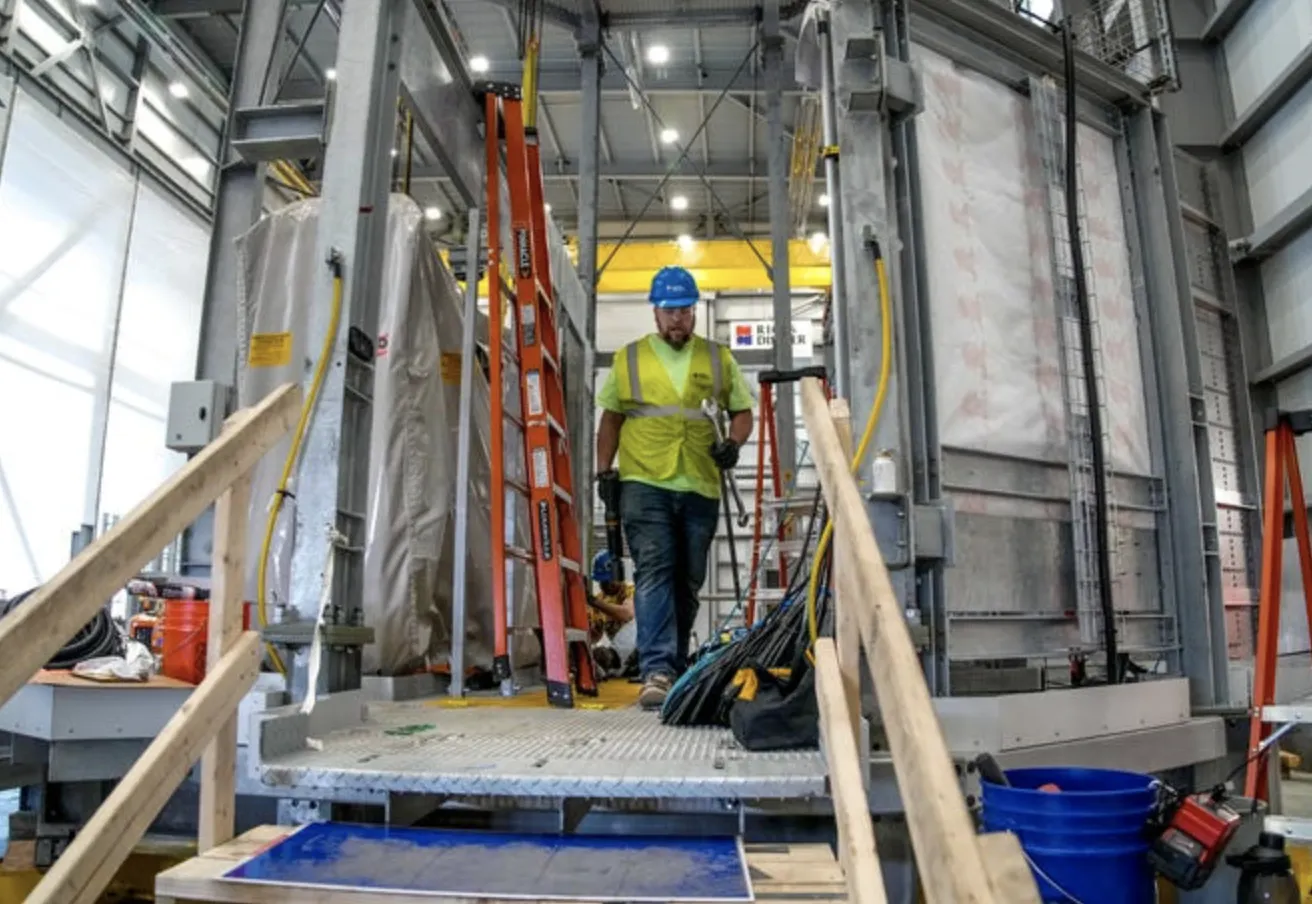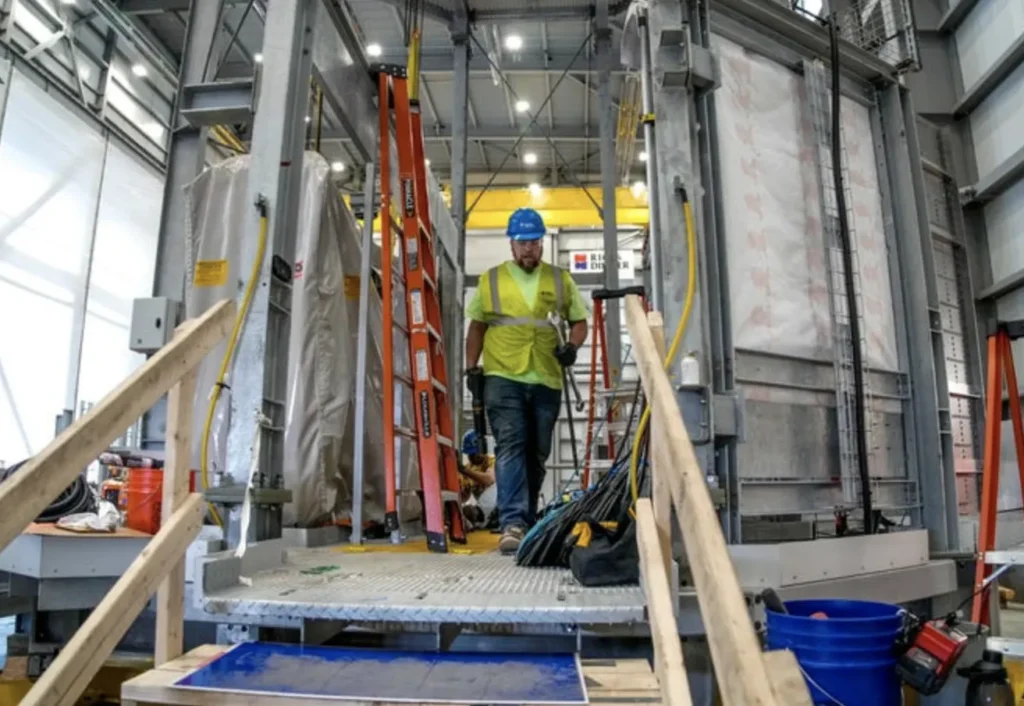The Providence Journal: The next few months will be big for offshore wind in America, and RI is playing a key role

Posted on April 7, 2023 in News
Riggs Distler was featured in a Providence Journal article highlighting their involvement as General Contractor for several wind project in the northeast, helping to realize the promise of offshore wind in the U.S.
View Full ArticleThe next few months will be big for offshore wind in America, and RI is playing a key role
By Alex Kuffner
The Providence Journal
PROVIDENCE — This is shaping up to be a transformative year for America’s offshore wind industry.
If all goes as planned, dozens of towering new wind turbines will be standing above the Atlantic Ocean waters off Rhode Island and Massachusetts by the end of the summer. And before the close of the year, their spinning blades should be generating lots of new power to be delivered through cables buried in the seabed to the New England electric grid.
The turbines will be installed as part of the nation’s first two major offshore wind farms, a pair of projects spurred on by construction of a five-turbine test array off Block Island in 2016.
It’s been nearly seven years since the Block Island Wind Farm broke new ground in America for the global offshore wind industry.
But at 30 megawatts, the wind farm built in Rhode Island state waters is tiny compared with the utility-scale energy projects currently under development in federal waters that will be able to power hundreds of thousands of homes.

More:Another big array of offshore turbines is proposed for RI. Here’s what’s in the wind.
Even before the completion of the Block Island project, developers had been eyeing much larger wind farms that could make a real difference in helping Rhode Island, Massachusetts and other states ramp up the use of renewable energy and reach their climate goals.
Activity around the industry picked up with the election of Joe Biden as president and his administration’s push to make offshore wind a cornerstone of efforts to wean the nation off fossil fuels and slash planet-warming greenhouse gas emissions.
The two sets of developers of the South Fork Wind Farm and Vineyard Wind never planned to build their projects at the same time, but the construction schedules have come together to make the next few months pivotal for both.
Building pieces of the South Fork Wind Farm in Providence
Inside a cavernous warehouse-like structure that looms over the Providence waterfront sit pieces of the South Fork Wind Farm in varying stages of completion.
Danish developer Ørsted and New England utility Eversource began offshore construction of their 132-megawatt wind farm only a few weeks ago, but here in the Port of Providence, 130 workers have spent the last year doing some of the most complex work on components for the monopile foundations that will be hammered into the ocean bed to secure the project’s 12 turbines in place.
“We’re trying to do as much work onshore as possible, because when we go offshore we want to be surgical and spend as little time as possible in that harsh marine environment,” said Paul Murphy, a director with Ørsted.
Working for contractor Riggs Distler, the crews, all members of local Rhode Island labor unions, are assembling 40-foot-tall platforms that will sit inside the cylindrical monopiles and hold mechanical, communications and electrical equipment crucial to the operation of the turbines.
Each platform will be lowered inside one of the hollow, 300-foot-long monopiles like an arm being slipped into a sleeve.
The construction workers are also building 130-ton concrete platforms that will be bolted onto the outside of the monopiles and will serve as the only access point to the turbines. Each one has a crane for carrying equipment and a hoist to lift technicians up from crew transfer vessels.
The last things they’re making are ring-shaped anode cages that will be dropped around the bottom of the monopiles to prevent them from rusting.
When the parts are finished, as soon as next month, they’ll be shipped out to the project site in the waters between Block Island and Martha’s Vineyard for installation.

The stage was set last month when the developers reached a project milestone by making a connection between the two parts of the 56-mile transmission cable that will send power from the wind farm to a substation on Long Island.
The moment when workers connected the first section of the 138-kilovolt electric line that will be buried under the ocean floor to the portion already installed on land marked the beginning of offshore construction for the wind farm.
And on April 3, the project hit another important mark when the U.S. Department of the Interior announced that it had signed off on the construction plan for South Fork’s turbines. The decision clears the way for the project to become the first offshore wind farm in federal waters to begin installing turbines, the department said.
Vineyard Wind also set to begin offshore construction
The two companies partnering on Vineyard Wind have also been busy laying the groundwork to start getting their turbines in the water this summer.
Avangrid Renewables, part of the Spanish renewable energy giant Iberdrola, and Copenhagen Infrastructure Partners, a Danish investment firm, broke ground on the onshore portion of their 64-turbine project two years ago.
With the project chugging along today, it’s easy to forget that not so long ago there were doubts about how it would overcome opposition from commercial fishermen and navigate through what was, under the Trump administration, an uncertain federal permitting process.
But with a change in administration, the developers refiled their application and in May 2021 the project became the first offshore wind farm to win approval from the Bureau of Ocean Energy Management. South Fork had its own problems trying to appease the fishing industry, but it became the second offshore wind farm to secure federal approval that November.
So far, the Vineyard Wind developers have built an onshore substation on Cape Cod and another one offshore at the site of the wind farm in federal waters south of Martha’s Vineyard. In recent weeks, they’ve been busy laying sections of the two transmission cables that will run between the substations.
The developers reached the sea-to-shore milestone for the cables a couple of months before the South Fork project, joining the two sections together in January at Covell’s Beach in Barnstable. They’re currently working on the near-shore, middle portions of the 34-mile-long cables.
Meanwhile, the 13-megawatt turbines being made by General Electric are set to arrive in New Bedford from France in a matter of weeks, along with blades from Canada, monopiles from Germany and other components. Installation of the foundations is set to begin in May or June.
About half of the turbines are expected to be completed this summer and are projected to start generating power before the end of the year. The remaining turbines would be installed when the marine construction window opens again in the spring of 2024.
More offshore wind farms expected off Rhode Island and Massachusetts
There are still more offshore wind projects set to come to the waters off Southern New England.
Next in line is Revolution Wind, a 704-megawatt project that Ørsted and Eversource are also developing in the same general area as their South Fork project. The companies have a contract to sell 400 megawatts of capacity to Rhode Island through cables that would make landfall at Quonset Point and would deliver the remaining 304 megawatts to Connecticut.
The developers are expecting a record of decision from the Bureau of Ocean Energy Management in July. Onshore cable work could start immediately afterward, offshore construction would follow in 2024, and the project could begin delivering power by 2025.
The same joint venture has proposed a second, larger phase of construction called Revolution Wind 2 that would sell 884 megawatts of power solely to Rhode Island. Rhode Island Energy, which would buy the power, is currently reviewing the proposal and expects to make a decision in June.
A trio of other proposals are also still on the table, despite recent difficulties. Last fall, Avangrid, which is developing two of the projects on its own, raised questions about the viability of contracts it secured to sell power, saying that inflation, the war in Ukraine and supply chain difficulties had made those contracts uneconomical.
The company is asking Connecticut to adjust the price in the contract for 804-megawatt Park City Wind. As for the contract with Massachusetts utilities for the 1,200-megawatt Commonwealth Wind, Avangrid has signaled its intent to scrap the agreement and a seek a new one.
The newly renamed Southcoast Wind secured a contract last year in Massachusetts at the same time as Commonwealth Wind. While Shell and its partners on the 1,200-megawatt project formerly known as Mayflower Wind have raised similar concerns about rising construction costs, they say they’ll stick to the agreement.
Port of Providence is becoming an offshore wind hub
The South Fork Wind Farm will send all of its power to Long Island, but it made sense to stage the assembly work at the Port of Providence for a couple of reasons. For one, the project site about 19 miles southeast of Block Island is closer to Rhode Island than it is to New York.
Second, the port already had experience with the type of work the developers needed. Eight years ago, Deepwater Wind, the company that developed the Block Island Wind Farm and was later bought by Ørsted, did similar finishing work on turbine components at a temporary facility in the port.
When Ørsted and Eversource were looking for a place to set up a permanent fabrication hub, it made sense to keep it in Providence, where workers had learned some of the mechanical and electrical expertise that the developers needed.
The companies also had relationships in place with Waterson Terminal Services, the port operator, as well as the Rhode Island Building and Construction Trades Council, the umbrella group that represents construction unions in the state.
The developers plan to use the facility not just for the South Fork project, but also for Revolution Wind and, if talks progress favorably with Rhode Island Energy, Revolution Wind 2, as well. They will also stage work there for Sunrise Wind, the 924-megawatt project that would supply power to New York and be built off that state’s coast.
“We’re looking to build a domestic supply chain for offshore wind at the same time that we have an imperative to meet the president’s 30-gigawatt by 2030 goal for the industry,” said David Ortiz, head of government affairs and market strategy at Ørsted. “The idea is that when we make investments like we have here, it carries through years and multiple projects.”
The new manufacturing facility in Providence was completed about a year ago, and it’s been humming with activity since.
Building “the brains of the foundations”
Over the next few weeks, a special installation ship will continue laying the submarine cable for South Fork. Once that work is complete, an offshore substation being built in Texas will be shipped north and installed. The monopile foundations will follow and then the turbines themselves.
Like those for Vineyard Wind, the project’s monopiles are being manufactured in Germany. Murphy says no company in the United States currently has the capability to make the 1,700-ton cylinders.
For the same reason, the 11-megawatt turbines are also being built overseas, by Siemens Gamesa in Germany and Denmark.
But the port’s facility is able to do the specialized work on components that include those internal platforms that Murphy describes as “the brains of the foundations.” It’s within the structures that the export cables will connect to the internal wiring from the turbines.
During a visit last month, a half dozen of the platforms stood inside the plant in various stages of completion. The other six were finished and stood upright overlooking the Providence River. A handful of the external concrete platforms sat nearby, as did the anode cages.
Work was nearing an end on the port’s piece of the project. But with final approval of Revolution Wind on the horizon and the possibility of another 65 turbines going in the water, any lull in activity is expected to be only temporary.
“Come back in a year, and we’ll have this whole place filled with components,” Murphy promised.
Share
Latest News

Riggs Distler Honored for Safety Excellence by ACCNJ and AGC of America
Posted on July 15, 2025
Riggs Distler is proud to be recognized by the Associated Construction Contractors of New Jersey with a 2025 Safety Award for maintaining a Lost Workday Incidence Rate below the national average in 2024 and a Certificate of Commendation from the Associated General Contractors of America for our outstanding safety performance in Utility Infrastructure.

Riggs Distler Employees Support the American Red Cross with Lifesaving Blood Donations
Posted on July 8, 2025
Since 2019, our employees have partnered with the American Red Cross to support lifesaving blood donation efforts, and the impact has been extraordinary.

Riggs Distler Earns 2025 Great Place To Work Certification™
Posted on April 3, 2025
Riggs Distler Earns 2025 Great Place To Work Certification™ for the Sixth Consecutive Year!
